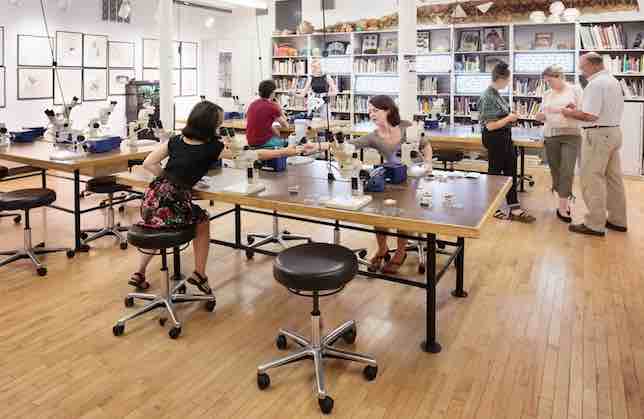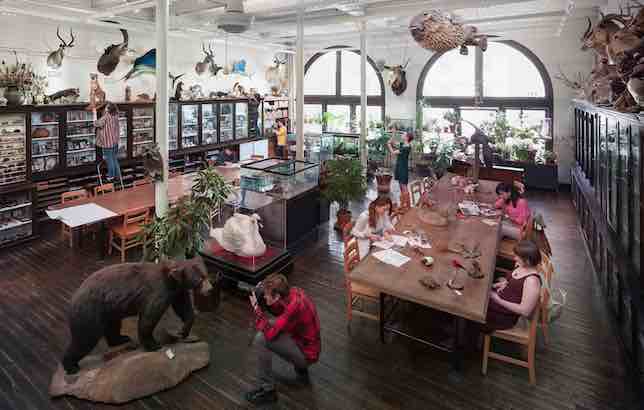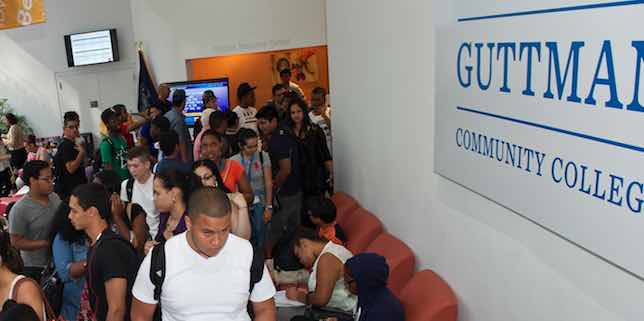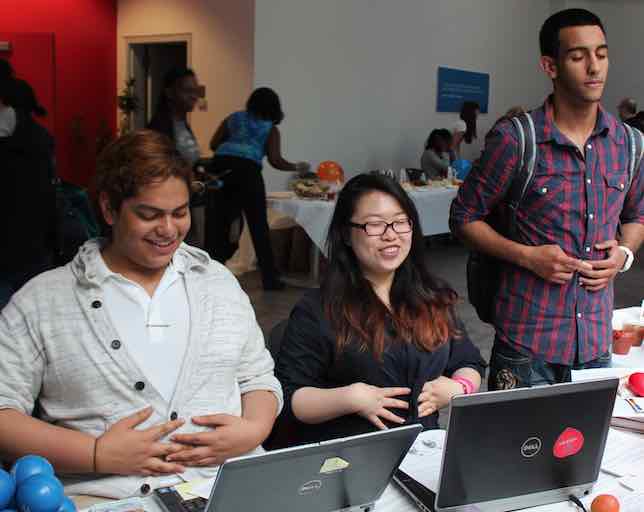ePortfolios that Make Learning Visible: Education Values in Product Design
A Q&A with Jeffrey Yan

"The art of asking questions is just as important as the act of answering them." — Jeffrey Yan
When Digication co-founders Kelly Driscoll and Jeffrey Yan started working on the first version of their ePortfolio software in 2001, they were early pioneers in the nascent field of ePortfolio technology. But they had an edge — they were both teaching at an institution they loved and were passionate about pedagogy. Every day, they were living the education principles their product needed to address. Sixteen years and some 6,000 institutional customers later, they have "stuck with" their pedagogical values. Here, Yan reflects on how his own experiences both as a student and teacher in higher education have influenced the design of his company's ePortfolio product.
Mary Grush: What was the main influence of your own higher education career on your early designs for Digication?
Jeffrey Yan: Back in 2001, my co-founder Kelly Driscoll and I were both faculty members at Rhode Island School of Design, and we had both graduated from there. We considered ourselves very, very fortunate — we loved our institution and what it stands for. We love the pedagogy there, both as students and as teachers.
At RISD there is an immense sense of the importance of making learning visible as the root of how learning happens. Of course, it is a design school, so, as you might expect, things are very visual. At the same time, all this exposed us to something that is really incredible — studio-based pedagogy, where the learning space itself is open and students can see what others are doing in their studio spaces. Some student works might be three feet tall; others may be the size of a room: You can't miss these projects as you walk into any studio. You are surrounded by all the research and processes that are developed over time. Naturally, there is a healthy social element, where students are always engaging and inspiring each other.
Also, RISD does another thing that's different from many non-art and design specific education programs: It doesn't focus on a lot of content distribution from professors to students. Faculty are not lecturing on "This is how you build a door" or "This is how you build a chair". Instead, they'll normally provide an organic prompt, where students are the ones to ask and seek the answers for their own questions. Kelly and I saw the power of pedagogy that is not all about content acquisition — it is more focused on developing metacognitive skills.
Finally, to support this pedagogy, RISD does not conduct exams in studio courses. Over the course of the whole semester, students work on projects of their own design and proposal. The art of asking questions is just as important as the act of answering them. Ongoing critiques throughout the semester support this aspect of the pedagogy. In a sense, the critiques serve as guided, reflective compositions that are very rigorous. The students, their teachers, and their peers all try to contribute through respectful and rigorous discourse, and document progress. This becomes highly personalized learning for each student, and it's done in a supportive, social environment.
So, Kelly and I had learned a pedagogy that is set apart from most schools. This gave us a lot of courage and a lot of faith in what we would do with Digication. When we started Digication we didn't set out with a "grand plan", but we were sure that the principles of learning we discovered at RISD work. We would be developing technology that would help make learning visible, and we were doing this for many good reasons.
Grush: Then you found that the technology — ePortfolio technology — helps make this type of pedagogy work in different contexts, not just at design schools?
Yan: Precisely.
Grush: What about the institutional aspects of what you were developing?
Yan: Just a few years after we founded Digication, we saw that there was increasing pressure for institutional assessment, nationally. We asked ourselves: How do institutions make the learning of perhaps thousands of students visible over time? How do institutions document their progress?
Remember, this was several years ago, and here again, I think I would be misleading you if I said this benefit for the institution was clearly there in our plans all along. We listened carefully to the needs of the schools, and we combined what we heard with what we knew, and what we felt was right.
Take a look back at the overall environment. It wasn't until about 2008 to 2010, that the general education landscape for assessment was tied to anything much beyond accreditation as we had known it in the distant past. By 2010, though, accrediting organizations were more vigilant in saying, "Hey, we don't just want your GPAs — they are important, but we want to tie authentic student work to learning outcomes."
They wanted to look at authentic student work, have real evidence of learning, and be able to do this comprehensively. As a result, many institutions focused their ePortfolio efforts on institutional applications. For Kelly and me, addressing this was a bit of a struggle, because for us, as I've said, our work was all about the pedagogy — our first priority and our first love.
Ultimately, we figured out how accreditation and institutional assessment work — and we managed to make all that work well with Digication's pedagogy. We would never let pedagogy get lost in the process. The elegance and importance of making learning visible had to come through on the institutional assessment side as well as the student side. We applied our initial basic concepts of making learning visible all the way from the individual student, through to the class, the program, and to the institution.
I would say that we probably helped carve out a trend in ePortfolios — institutions began to recognize that ePortfolios could really help them understand how they are doing, in terms of how they are reaching their students and how their students are learning. This recognition was supported by the industry, though organizations like AAEEBL, AAC&U, and by many institutions in the ePortfolio movement.
Grush: How else did the environment for ePortfolios change over time?
Yan: We've seen the rise of so many new technologies and practices over our 16 years… Wikis, Blogs, MOOCs, mobile, iPhones, Facebook, Open Education Resources, digital collections, rubrics, flipping the classroom, big data, intervention systems… a few have come and gone; many are still around. Some have been more impactful for the ePortfolio movement than others. Today, in the ePortfolio practice, a lot of things are much easier — Web and mobile technologies, for example, are light years ahead of when we started our work on Digication, increasing the flexibility of ePortfolio platforms and making adoption easier. User behavior and psychology surrounding the use of technology in the classroom have changed completely. It would be difficult now to find anyone fundamentally opposed to using technology in the classroom — this was not always the case!
The main impact for us, though, is that it is now so much easier to get people — students, faculty, administrators — "on board" and "up to speed" with ePortfolios, and this has been good for education.
Grush: Is there something in particular, or maybe a couple of these changes you'd like to highlight more specifically?
Yan: There is something particularly interesting for us about MOOCs and the flipped classroom. We know that, especially initially, MOOCs did not seem to live up to their hype. But there is still plenty of momentum, with more and more MOOCs becoming available all the time. The interesting thing for us, is that the MOOC is a good mechanism for delivering content — it's like having a super-powered library to access content you need efficiently. So in the classroom, we don't have to spend time delivering content when we'd prefer to be more engaged with students in active learning, or critiquing their projects.

Drawing on another example from our experience at RISD, the school has something called the Nature Lab. It has developed a collection over the years of more than 80,000 natural objects or specimens. Almost anything you'd want, from butterfly samples, to plants — you can easily locate and "take out" a sample for study. It's another form of content acquisition — maybe "DYI content acquisition," of content that can be experienced. It is great to see students make the leap from accessing resources, to asking their own questions, as well as answering them.
Grush: What about the next 16 years? I know you can't literally predict what's going to happen, but how do you prepare for coming change? What are you watching?
Yan: I'll try to answer your questions by starting with one of my favorite examples of what I hope to see more of in the future.

Not long ago I was really fortunate to be working with Guttman Community College, established in 2011 and CUNY's first new community college in more than 40 years. This institution was built from scratch, in a sense, with the freedom to reimagine what a school can be. Their structure is based on team teaching: A course will normally include a faculty member for the subject domain, two experienced student mentors, and another team member who takes on a mix of academic and career advising. Given this team, the value of higher education shifts substantially toward developing the student as a whole. The team approach has been a wonder to watch as it unfolds and matures at Guttman. I'm seeing brilliant work there. And the team approach fits in well with the pedagogy Kelly and I have always tried to support in our ePortfolio development.

Another example is one that I've witnessed at the University of Notre Dame in the realm of advanced data analytics. ND was able to create a team of data scientists to help analyze a massive amount of student work both quantitatively and qualitatively. The initial results were already staggering, giving insights into how students learn — insights provided in ways that were simply not possible before. I look forward to seeing how big data and AI will positively impact education.
I've had the privilege of working with many, many other institutions that have amazing programs and are trying unique, innovative approaches. So there are many other extraordinary examples I could add here. But the key thing that will help answer your questions, I think, is to note that there are exciting changes beginning — some may happen more quickly than others — in the very nature of teaching.
Grush: Is this an instructional design issue to track?
Yan: Yes, that landscape is changing.
We can see the landscape of instructional design changing in many areas. For example, some institutions are putting more emphasis now on the co-curricular as they realize just how important student life activities are and find more effective ways to recognize and document them. You can also review some of George Kuh's high-impact practices that are upheld by the AAC&U — things like travel and programs abroad have of course been around for a long time, but they may receive much more attention in the future, given the technologies we have to document experiential and authentic learning.
When I talk with curriculum planners and strategic officers at higher education institutions, I'm finding that the co-curricular, student government, clubs, and other aspects of student life and experiential learning are now manifest as important aspects of a student's college career — in some cases offering more of a chance for maturity and competence building than the student's academic coursework.
Grush: As we bring the co-curricular into the light — areas that historically have been "off the grid" in terms of transcripts and reporting — what kinds of partnerships will institutions need to develop across campus and beyond in order to track and recognize students' co-curricular and student life activities?
Yan: Again, our technology tools will help us drive this, but cooperation and partnering from interested parties both on and off campus will be needed. Cross-disciplinary and interdepartmental partnerships on campus will help with this, of course. And a little effort there will bring ample rewards to everyone involved.
Additionally, I think corporate partnerships may grow as we begin to consider the larger ecosystem. In the past, corporations didn't have much input to our institutions. Academic programs seemed to be in a protective bubble. But corporations' abilities to contribute may be boosted with tools like ePortfolios. This technology can potentially help students develop meaningful relationships with multiple corporate partners while they are still in school. And this can be seen as another aspect of the co-curricular, if institutions do not wish to involve companies directly in their academic programs. It may be worth a refrain here, that given the rate of change within the professions, students will benefit more from learning metacognitive skills than specific tasks — so having relationships with these companies would not be likely to promote narrow skill sets. Students will not have to be limited by instruction on any single platform. Instead, they will be preparing themselves to be better able to navigate the sea of change and diversity that is waiting to meet them upon graduation.
Grush: We've touched on just a few of the concepts and issues that you work with every day. Are you looking forward to the next 16 years?
Yan: More than ever. The future of higher education, K-12, and life-long learning will all be affected by the types of efforts we've talked about in this conversation and powered by technology tools that will help us create value for learners as never before.

[Editor's note: Images courtesy Guttman Community College and the Nature Lab at RISD. Nature Lab photos by Matthew Clowney.]